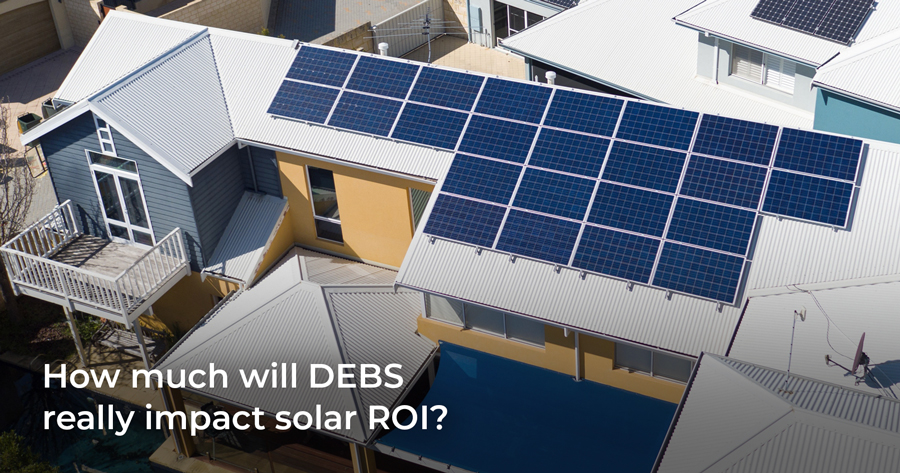Case Study: How Much Will DEBS Really Impact on Solar ROI?

With the WA state government’s recent move from the Renewable Energy Buyback Scheme (REBS) to the new Distributed Energy Buyback Scheme (DEBS), there has been some confusion about how much difference the change may make to the return on investment for those who invest in solar.
At Infinite Energy, we believe that a solar PV system is a wise investment for any residential household who wants to reduce their reliance on the grid and save money on their energy bills, but we understand that the changes have caused some hesitancy from potential solar investors.
Under REBS, those with a solar PV system are paid 7.135 cents for each unit of electricity sent to the grid. For those participating in DEBS, the feed-in tariff is 3 cents per kWh before 3pm, and increases to 10 cents per kWh between 3-9pm.
We’ve done the maths to determine how much of a difference it would make for one of our current customers if they moved from the REBS scheme to the new DEBS scheme.
Meet our customer, Mr M.
Mr M has invested in a 6.6kW system on his home in WA and his panels are split to cover the North and West directions. Because of this, he has a pretty consistent generation of power from his solar panels throughout the day. Mr M has been quite particular about his energy use and last year, self-consumed about 56% of his solar energy, and sent 44% back to the grid, which earns him a feed-in tariff.
In 2019, Mr M’s solar PV system produced a total of 11.19MWh of solar energy. He self-consumed 6.24 MWh and 4.95 MWh were sent to the grid. Under REBS, Mr M receives a flat 7.135c per kWh that he exports back to the grid as a feed-in tariff.
Mr M’s savings with REBS
To calculate Mr M’s savings, we multiply 6,240 (energy self-consumed) by $0.2883 (cost of energy from the grid) to calculate the money he saved by self-consuming the energy produced by his solar PV system, and then multiply 4,950 (energy he exported to the grid) by $0.07135 (the feed-in tariff amount) to calculate the credit received from REBS. These two figures are then added together.
Using those figures, we can see that the total savings from his solar PV system under REBS is $2,152.
Total Savings on REBS = (6,240 x $0.2883) + (4,950 x $0.07135) = $2,152
Mr M’s savings with DEBS
If Mr M. upgrades his solar system, or if he purchased it after the REBS application end date, September 7 2020, he could apply to participate in the new DEBS scheme. Instead of the flat 7.135 cents per kWh, he would instead receive 3c per kWh exported to the grid before 3pm and 10c per kWh exported to the grid between 3pm and 9pm.
We are going to assume, like many households, the majority of his energy consumption occurs between 3pm and 9pm, and he is not sending any energy to the grid, therefore not benefitting from the 10c feed-in tariff, only the 3c feed-in tariff he receives during the day before 3pm. This is an absolute worst-case scenario.
To calculate Mr M’s savings under DEBS, we multiply 6,240 (energy self-consumed) by $0.2883 (cost of energy from the grid) to work out the money he saved by self-consuming. We then multiply 4,950 (energy he exported to the grid) by $0.03 (feed-in tariff amount) to calculate the credit received from DEBS, and then add those two figures together.
Total savings on DEBS (Worst Case Scenario) = (6240 x $0.2883) + (4950 x $0.03) = $1,947
Using those figures, we can see that his total savings from his solar PV system under DEBS is $1,947
Even under an absolute worst-case scenario, the reduction in savings under DEBS amounts to only $205 over the whole year.
If we assumed that there is a portion of solar energy generated and not self-consumed during the 3pm and 9pm period (for example, if Mr M. and his family don’t get home from work until after 5pm), there would be a portion of energy generated by Mr M.’s solar panels which would be exported back to the grid, earning the 10c feed-in tariff. Judging from Mr M’s past use, this would be an average of 10% of his power. Based on this information, we can get a more accurate view of Mr M’s savings.
To calculate Mr M’s actual savings under DEBS, we multiply 6,240 (energy self-consumed) by $0.2883 (cost of energy from the grid) to work out the money he saved by self-consuming. We then multiply 495 (energy he exported to the grid between 3 and 9pm) by $0.10 (feed-in tariff amount) and then multiply 4,455 (energy he exported to the grid at all other times) by $0.03 (feed-in tariff amount) and to calculate the credit received from REBS, and then add those three figures together.
Total savings on DEBS = (6,240 x $0.2883) + (4,455 x $0.03) + (495 x $0.10) = $1,982
Using those figures, we can see that his total savings from his solar PV system under DEBS is $1,982
Under this scenario, the reduction in savings under DEBS amounts to only $170 over the whole year, ultimately very little difference.
To find out more about how you can best take advantage of the new DEBS scheme, or to chat about investing in a solar PV system or battery for your home, get in touch with us today by calling 1300 074 669 to speak with one of our experienced Energy Consultants.


